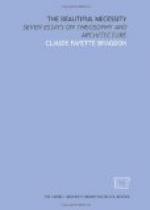In such a spectrum of the arts each one occupies a definite place, and all together form a series of which music and architecture are the two extremes. That such is their relative position may be demonstrated in various ways. The theosophic explanation involving the familiar idea of the “pairs of opposites” would be something as follows. According to the Hindu-Aryan theory, Brahma, that the world might be born, fell asunder into man and wife—became in other words name and form[A] The two universal aspects of name and form are what philosophers call the two “modes of consciousness,” one of time, and the other of space. These are the two gates through which ideas enter phenomenal life; the two boxes, as it were, that contain all the toys with which we play. Everything, were we only keen enough to perceive it, bears the mark of one or the other of them, and may be classified accordingly. In such a classification music is seen to be allied to time, and architecture to space, because music is successive in its mode of manifestation, and in time alone everything would occur successively, one thing following another; while architecture, on the other hand, impresses itself upon the beholder all at once, and in space alone all things would exist simultaneously. Music, which is in time alone, without any relation to space; and architecture, which is in space alone, without any relation to time, are thus seen to stand at opposite ends of the art spectrum, and to be, in a sense, the only “pure” arts, because in all the others the elements of both time and space enter in varying proportion, either actually or by implication. Poetry and the drama are allied to music inasmuch as the ideas and images of which they are made up are presented successively, yet these images are for the most part forms of space. Sculpture on the other hand is clearly allied to architecture, and so to space, but the element of action, suspended though it be, affiliates it with the opposite or time pole. Painting occupies a middle position, since in it space instead of being actual has become ideal—three dimensions being expressed through the mediumship of two—and time enters into it more largely than into sculpture by reason of the greater ease with which complicated action can be indicated: a picture being nearly always time arrested in midcourse as it were—a moment transfixed.
In order to form a just conception of the relation between music and architecture it is necessary that the two should be conceived of not as standing at opposite ends of a series represented by a straight line, but rather in juxtaposition, as in the ancient Egyptian symbol of a serpent holding its tail in its mouth, the head in this case corresponding to music, and the tail to architecture; in other words, though in one sense they are the most-widely separated of the arts, in another they are the most closely related.




